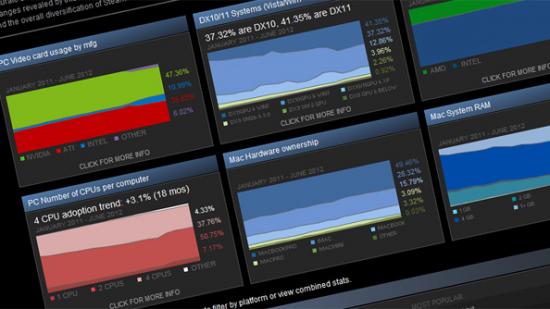The results of June 2012’s Steam hardware survey have just been published on the Valve site, and there’s something interesting going on. According to the data, PC’s are getting slower.
The Steam hardware survey is a rolling survey that continually polls a segment of the Steam audience to see what hardware is being used. Before we continue, it’s important to note that the data on display is affected by a bug that Valve introduced earlier this year that prevented new computers from being polled. The effect of this is that any changes appear to be suddenly introduced in April 2012, when the bug was fixed. The trends remain the same; it’s just they appear all of a sudden.
Here are the interesting data points.
The first: the rise of Intel Integrated Graphics. Traditionally, Intel’s integrated graphics aren’t suitable for gaming – but now 11% of computers polled by the Steam survey rely on them, from a rolling average of between 3% and 4%.
The second: the increasing volume of dual core processors: previously on the decline, from 48% of PCs polled, to 50%. Similarly, the percentage of computers using single core processors has increased from 5% to 7%.
Digging further into the numbers, the growth rate in GPUs is at the low end. The proportion of DirectX 11 GPUs increased only by .06% over the course of the survey. DirectX 10 GPUs increased by half a percentage point. But DirectX 9 level GPUs (including the various types of shader model) increased by 1.5%, making up nearly 20% of the total number of PCs polled.
Most interesting though, is combing through the resolutions Steam users use.
The most popular resolution, by far, is 1920×1080 – that makes up 25% of the Steam userbase. The second most popular resolution is 1366×768, at 18% of Steam computers. 1680×1050 follows at 10%, then 1600×900 at 7%.
Here’s what I think is going on: gamers are starting to install Steam onto their laptops.
It’s important to note that the bug mentioned earlier meant that new installs of Steam weren’t being properly polled by the Steam survey program. That meant that if, say, you’d installed Steam on your main PC a few years ago, but recently installed it on a laptop, that laptop may not have been checked.
But the data supports the hypothesis. A bit. The growth of dual core processors, integrated graphics, and DirectX 9 GPUs suggest that lower spec PCs are being added into the mix. The growth of the laptop friendly 1366×768 resolution suggests they’re portables.
What’s more, the big success story of the past two years of PC gaming is in the growth of smaller indie games that require a low end PC to run: think Dungeons of Dredmor, Super Meat Boy, Plants vs Zombies, Dungeon Defenders, Torchlight and Terraria. There’s the success too, of the Humble Indie bundles, which are mostly distributed as Steam keys.
Meanwhile, there are a number of publishers pursuing projects that work increasingly well on a laptop: think Civilization, Total War (Creative Assembly have put a lot of work in making the latest Total War games playable on laptops) and the monster that is Football Manager.
Put simply: there are lots of very good reasons to install Steam on your laptop.
There are a couple of other possibilities. The first is Steam’s growth outside of the West, where there might be many lower end PCs still in circulation. The data for the Windows language used doesn’t help here: the language use is mostly stable, with the only significant increase seen in PCs set to English.
The second is slightly oddball, but worth considering. I wonder if the incredible success of Minecraft might have a minor influence on PC gaming in general. Minecraft doesn’t need a high-end PC to run at all – it’s the kind of game you install on an older PC or laptop which you then hand it over to your younger brother or sister. I’d love for this to be true – it would mean that there’s a whole new generation of PC gamers growing up, and they’re gradually being introduced to the PC’s amazing back catalogue via Steam.
